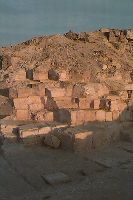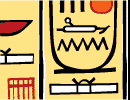|
About
Abu Roash
Located
5 miles north of Giza, Abu Roash was the site that the first son of Khufu,
Djedefre, chose to build his pyramid. Typically, as successor, it was Djedefre's
responsibility to attend to the completion of his fathers entombment. It was
then time for Djedefre to begin the construction of his own tomb. Because
of the present state of the site, some experts believe that this pyramid was
never finished. Others contend that extensive quarrying has been done at the
site and the pyramid has been effectively dismantled over the ages. Whatever
the case, the pyramid itself was unique in several ways. Firstly, the subterranean
chamber is more like those of step pyramids, and therefore unlike that of
the more modern "true" pyramids. Secondly, the angle of the pyramid
may have been very steep, approx. 60 degrees, according to the angle of some
of the recovered casing stones. Also, the descending chamber was very wide,
about 14 feet wider in places than any other known pyramid. It is believed
that at least some of the pyramid was cased in granite, most likely the lower
courses, as is evidenced by the abundance of granite fragments scattered around
the site. A boat pit was also found at the site, although it had been long
since empty. The causeway of this pyramid was also atypical, running from
noth to south, instead of the typical east to west orientation. Excavations
on the early 1900's uncovered three red quartzite heads of Djedefre. Two are
in the Louvre in Paris and one is in the Egyptian Museum in Cairo.
 The
Pyramid of Djedefre
- Djedefre, son of Khufu chose to build his pyramid at a different site
from that of his father. If completed at all, the tomb was not as big
as that of his father, though it may have had the steepest angle of any
known pyramid. Although little remains of this pyramid, we can still learn
about the evolution of pyramids by visiting this interesting site. The
Pyramid of Djedefre
- Djedefre, son of Khufu chose to build his pyramid at a different site
from that of his father. If completed at all, the tomb was not as big
as that of his father, though it may have had the steepest angle of any
known pyramid. Although little remains of this pyramid, we can still learn
about the evolution of pyramids by visiting this interesting site.
Special thanks to:
Guardian's Egypt - Copyright © 1995-99 Andrew Bayuk All Rights Reserved
|
|





